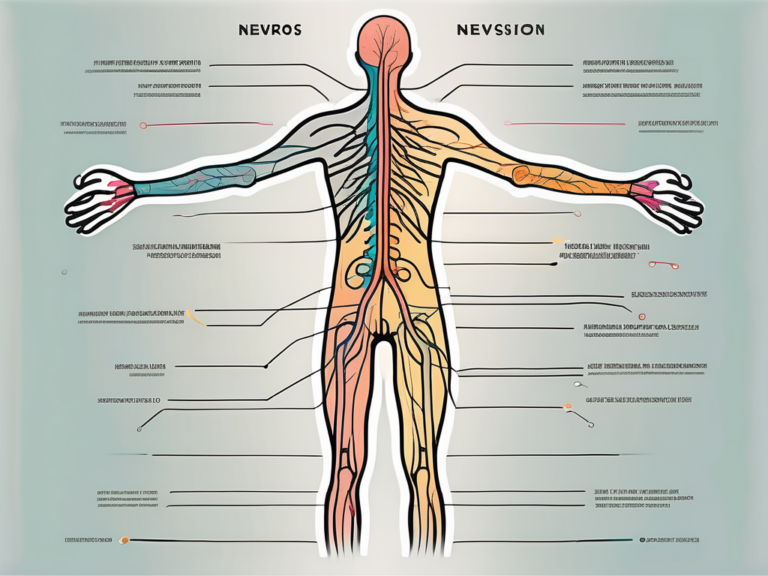Explaining Accessory Nerve to kids
Welcome, young learners, to a captivating journey into the world of the nervous system! Today, we will unravel the mysteries of the accessory nerve and discover its vital role in our bodies. So, get ready to dive into the intriguing realm of this fascinating nerve!
Understanding the Nervous System
The nervous system comprises an intricate network of special cells called neurons, the building blocks of communication within our body. It controls everything we do, from breathing and blinking to speaking and running. Let’s take a closer look at how the nervous system operates.
Neurons are like messengers, carrying information through electrical and chemical signals. They form complex pathways that allow our brain to communicate with different parts of the body. This intricate network ensures that every movement, sensation, and thought is coordinated seamlessly.
The Role of the Accessory Nerve
One significant player in the nervous system is the accessory nerve. You might be wondering, “What exactly does the accessory nerve do?” Well, its primary function is to supply specific muscles in our neck and shoulders, allowing us to move our heads, shrug our shoulders, and engage in other intricate movements. It helps us express ourselves through a wide range of physical actions!
The accessory nerve, also known as cranial nerve XI, works in conjunction with other nerves to ensure smooth coordination of movements. It plays a crucial role in maintaining posture, stability, and range of motion in the upper body. Without the accessory nerve, simple tasks like turning our heads or lifting our shoulders would be challenging to perform.
How Nerves Communicate with the Body
Before we delve deeper into the accessory nerve’s inner workings, let’s understand how nerves communicate with our bodies. Nerves use electrical signals to transmit messages between the brain and different parts of our body. These signals travel at incredible speeds, allowing us to respond quickly to external stimuli.
Imagine your brain as a control center, sending signals down various nerve pathways to activate specific muscles. Just like a superhero, the accessory nerve is responsible for controlling specific muscles that other nerves can’t reach!
Furthermore, the communication between nerves and muscles is a precise and coordinated process. When a nerve signal reaches a muscle, it triggers a series of events that result in muscle contraction or relaxation. This intricate dance between nerves and muscles is essential for our ability to move, react, and interact with the world around us.
Simplifying the Accessory Nerve
Now that we’ve laid the foundation for understanding the nervous system, let’s simplify the concept of the accessory nerve so that even the youngest minds can comprehend its significance.
Before we delve further into the intricacies of the accessory nerve, let’s take a moment to appreciate the marvel that is the human body. Our nervous system is a complex network of nerves and cells that allows us to perceive the world around us, move our muscles, and experience sensations. It’s truly a work of art crafted by nature!
The Accessory Nerve in Simple Terms
Imagine you are playing a video game where you control a virtual character. Your accessory nerve works similarly—it controls some specific muscles in your body. Just like you press buttons or move a joystick to make your character move on the screen, your brain sends signals through the accessory nerve to make certain muscles in your neck and shoulders move. Isn’t that amazing?
Now, let’s take a moment to visualize the intricate dance of signals that occurs within your body every time you move. The accessory nerve plays a crucial role in this symphony, ensuring that your neck and shoulder muscles work in harmony to carry out your commands. It’s like having a built-in conductor orchestrating a flawless performance!
Fun Facts about the Accessory Nerve
Here’s a fun fact to spark your curiosity: the accessory nerve is the eleventh cranial nerve in our body. It pairs up with another nerve called the vagus nerve, which is responsible for many critical functions, such as breathing and controlling our heart rate. Together, they form an unstoppable team that ensures our bodies function harmoniously!
As you ponder the wonders of the accessory nerve, consider the incredible precision with which our bodies are designed. Every nerve, every muscle, and every signal work together seamlessly to help us navigate through the world. It’s a testament to the intricate beauty of human anatomy!
The Function of the Accessory Nerve
Now that we have a grasp on the simplified concept of the accessory nerve, let’s explore how it works and why it is so important.
The accessory nerve, also known as cranial nerve XI, is a complex and fascinating component of our nervous system. Beyond its basic functions, this nerve delves into a realm of intricate connections and precise movements that contribute to our daily experiences.
How the Accessory Nerve Works
The accessory nerve starts from the brain and travels all the way down to our neck and shoulders. As it progresses, it branches out to connect with specific muscles, enabling us to perform various actions. Whether you’re showing enthusiasm through a vigorous headshake or lifting your shoulders to express doubt, it’s the accessory nerve that makes it all possible!
Moreover, the accessory nerve collaborates with other nerves and muscle groups to execute coordinated movements. This intricate dance of signals and contractions allows for the seamless performance of tasks as simple as turning your head to check your blind spot while driving or as complex as executing a perfect pirouette in a ballet performance.
The Importance of the Accessory Nerve
While every nerve in our body plays a crucial role, the accessory nerve is particularly essential for our everyday movements. Just imagine trying to turn your head without the accessory nerve! It provides us with the freedom and flexibility to engage in a wide range of physical activities, making our lives more enjoyable and expressive.
Furthermore, the accessory nerve’s significance extends beyond physical movements. It also plays a role in non-verbal communication, allowing us to convey emotions and intentions through subtle gestures. From a slight tilt of the head to a shrug of the shoulders, the accessory nerve contributes to the richness and depth of human interaction, enhancing our ability to connect with others on a profound level.
Disorders Related to the Accessory Nerve
Like any superhero, the accessory nerve sometimes faces challenges. Let’s explore some common problems people may experience with this remarkable nerve and how doctors treat them.
The accessory nerve, also known as cranial nerve XI, is a crucial component of the nervous system responsible for controlling certain muscles in the neck and shoulders. This nerve works in conjunction with the spinal nerves to ensure smooth and coordinated movements of the head and upper body. Despite its importance, the accessory nerve can encounter issues that disrupt its normal functioning, leading to discomfort and limitations in movement for individuals.
Common Problems with the Accessory Nerve
Although it doesn’t happen frequently, some people may experience conditions where the accessory nerve doesn’t work as it should. This can lead to difficulties in moving the neck and shoulder muscles properly. However, with the help of healthcare professionals, these challenges can be managed effectively.
One common disorder related to the accessory nerve is known as accessory nerve palsy, which can result from trauma, surgery, or certain medical conditions. Symptoms of this condition may include weakness or paralysis of the shoulder and neck muscles, leading to issues with activities like lifting the arms or turning the head. Proper diagnosis and treatment are essential to address these concerns and improve the individual’s quality of life.
How Doctors Treat Accessory Nerve Disorders
When someone faces issues with their accessory nerve, doctors may recommend various forms of treatment. These can include specialized exercises to strengthen the muscles associated with the nerve, physical therapy sessions, or in specific cases, surgical interventions. It’s essential to remember that medical professionals are here to help us overcome these hurdles!
Additionally, techniques such as nerve mobilization and biofeedback therapy may be employed to enhance nerve function and promote healing. Patients are encouraged to actively participate in their treatment plans to optimize outcomes and regain optimal movement capabilities. By working closely with healthcare providers and following their recommendations, individuals can navigate through accessory nerve disorders with resilience and determination.
Keeping Your Nervous System Healthy
Now that we understand the wonders of the accessory nerve, let’s explore how we can take care of our overall nervous system to ensure it remains fit and strong!
Healthy Habits for a Strong Nervous System
To maintain a healthy nervous system, it’s essential to lead a balanced lifestyle. Engaging in regular exercise, getting enough sleep, and eating a nutritious diet filled with fruits, vegetables, and whole grains are all essential for overall well-being. Remember, a healthy lifestyle helps support the incredible work done by our accessory nerve and the rest of our nervous system!
The Impact of Diet and Exercise on the Nervous System
Did you know that exercise and diet can influence how our nervous system functions? Regular physical activity and a balanced diet provide the necessary nutrients and oxygen to our brains, improving cognitive function and contributing to a strong and healthy nervous system. So, don’t forget to get moving and eat your fruits and veggies!
But what about other factors that can affect our nervous system? Let’s delve into the fascinating world of stress and its impact on our delicate network of nerves. Stress, whether it’s caused by work, relationships, or external circumstances, can have a profound effect on our nervous system. When we experience stress, our bodies release stress hormones that can disrupt the normal functioning of our nerves. This can lead to symptoms such as anxiety, irritability, and difficulty concentrating.
Fortunately, there are ways to manage and reduce stress to keep our nervous system in top shape. Engaging in relaxation techniques such as deep breathing, meditation, and yoga can help calm our minds and promote a sense of well-being. Additionally, finding healthy outlets for stress, such as engaging in hobbies or spending time in nature, can provide a much-needed respite for our nerves.
So, young explorers, we have embarked on an adventure to unravel the intricate wonders of the accessory nerve and the captivating realm of the nervous system. We hope that through this journey, you’ve gained a deeper understanding of how this incredible nerve works and the vital role it plays in our bodies. Remember, our bodies are like a symphony of nerves, working in perfect harmony to help us express ourselves and enjoy every moment of life’s adventures!






